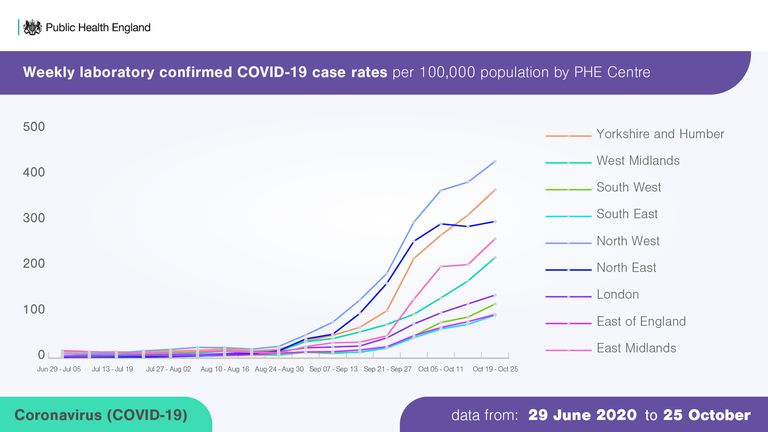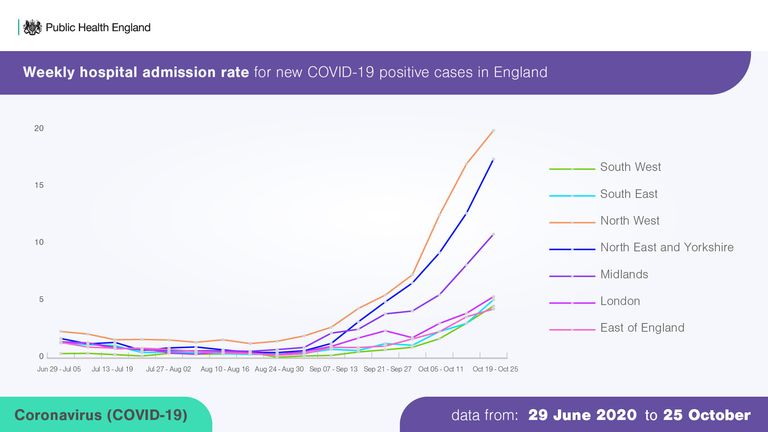Coronavirus: What the latest data tells us about the spread of COVID-19
Today saw more worrying data about the spread of coronavirus in England.
Cases and deaths remained at the high levels seen last week, as did hospitalisations.
Across the country, the spread shows little sign of slowing.
As before, the highest numbers are in the North West, but the highest rates of growth are in other regions.
A useful indication of the state of the outbreak is the number of beds occupied by patients suffering from COVID-19.
In the East of England, that figure jumped from 295 to 454, a 55% rise.
In the South East, it went from 325 to 528, a rise of 62%.
Large percentage increases don’t mean that much when the absolute numbers are low – after all, if you go from 10 to 20 cases you’ve had a percentage rise of 100%.
But this does suggests the virus is now spreading across the country, even in regions where it has previously been low.
Things are not as bad as they were in March – thanks to continued social distancing, the doubling rate appears to be around two weeks.
Back in March, it was between 3 and 3.5, which meant cases were roughly quadrupling every week.
Even if you take the estimate of Imperial’s REACT study, which suggests that the doubling rate is nine days, you’re still some way off the terrifyingly steep growth of the peak of the pandemic.
Still, stopping the spread is not going to be easy.
So what about the measures the government has taken?
Clearly, Test and Trace in England is struggling.
For the third week in a row, official figures showed that it reached around 60% of contacts in England, far less than it needs to if it’s going to restrict the virus effectively.
To its credit, Test and Trace is reaching greater numbers of people each week, the problem is that the number of cases keeps on increasing.
According to the most recent data for 15 to 21 October, the service reached 0.6% more people than the week before.
Yet in the same week, cases transferred to the system rose by 25% – the improvement is just too small to stem the flow.
:: Subscribe to the Daily podcast on Apple Podcasts, Google Podcasts, Spotify, Spreaker
This, of course, is why we have tougher restrictions.
It’s now been two-and-a-half weeks since Boris Johnson introduced the three-tier system of coronavirus restrictions for England.
If they were going to have an impact, you’d expect to start to see it about now.
Liverpool was the first city to go into Tier 3 lockdown – and, since the restrictions came in, its case rate has noticeably declined.
There are still lots of infections, including among older people, and Liverpool City Council warns of “widespread community transmission of the virus”.
Nevertheless, the decline is now more than two weeks old, and regional estimates of the R number put it below one.
Does this mean the restrictions are working? The answer is complicated, because cases in Liverpool began to decline before Tier 3 was introduced.
But it’s possible that warning of Tier 3 may have caused the effect, and it seems likely that the measures accelerated the decline.
Critics will argue that the tier restrictions are reactive rather than proactive, so they invariably come too late.
But it’s rare these days that things are pointing in the right direction, amid a deluge of dismal data, we have to take every glimmer of hope we can get.
Source: Read Full Article




